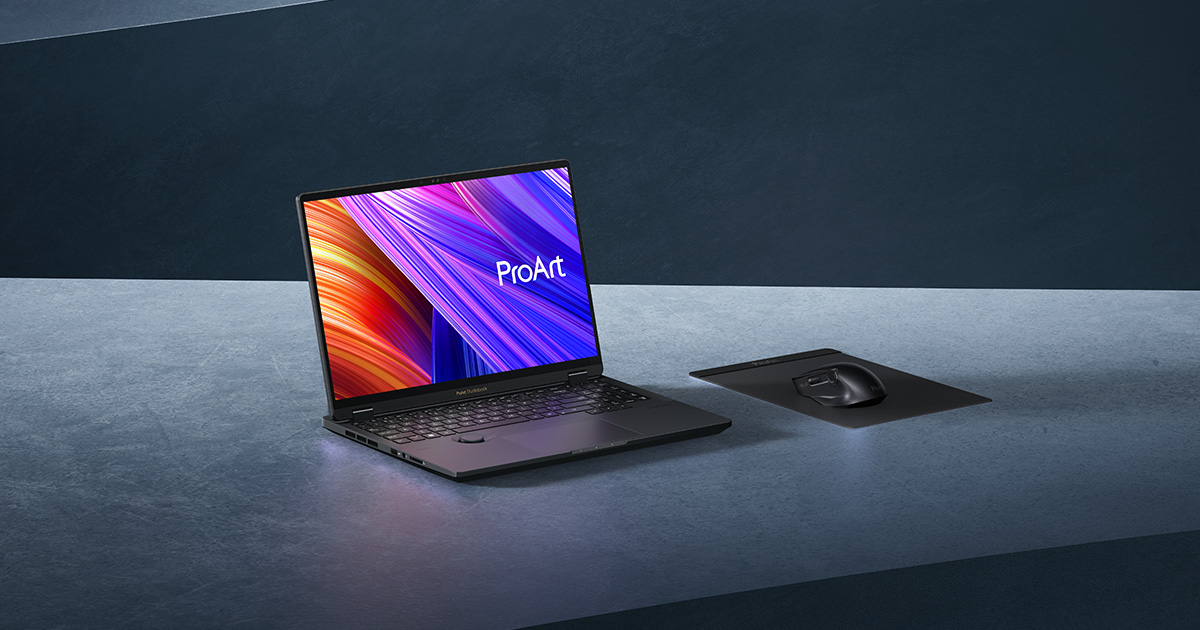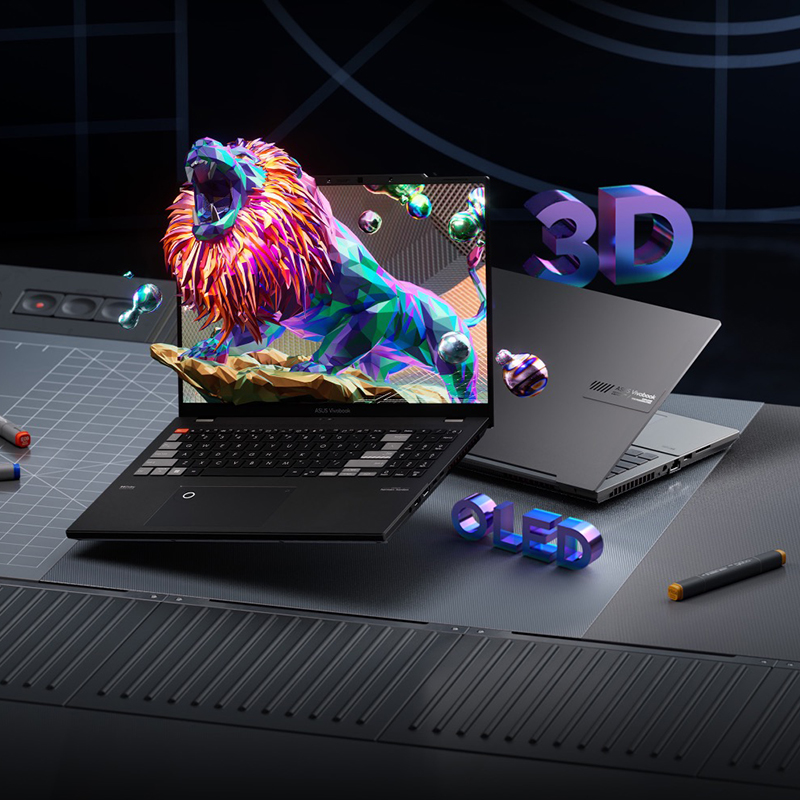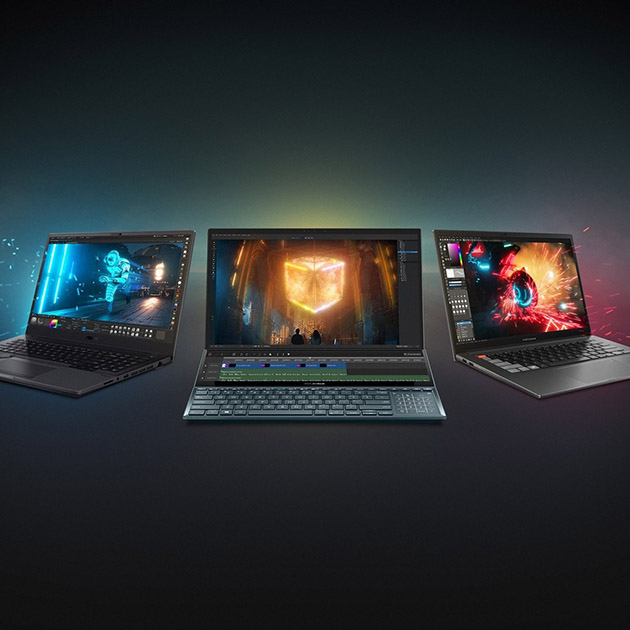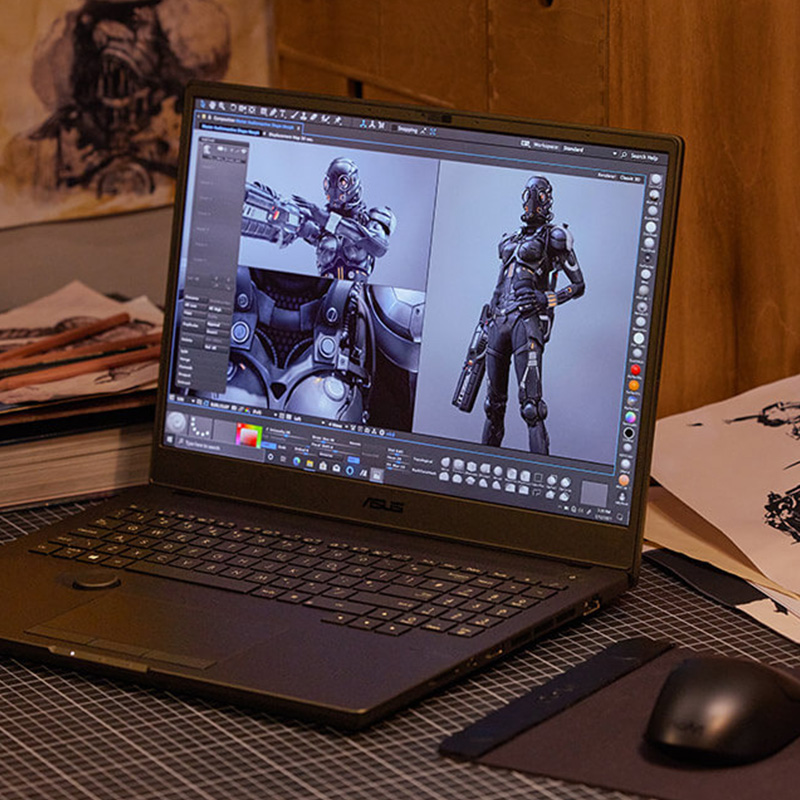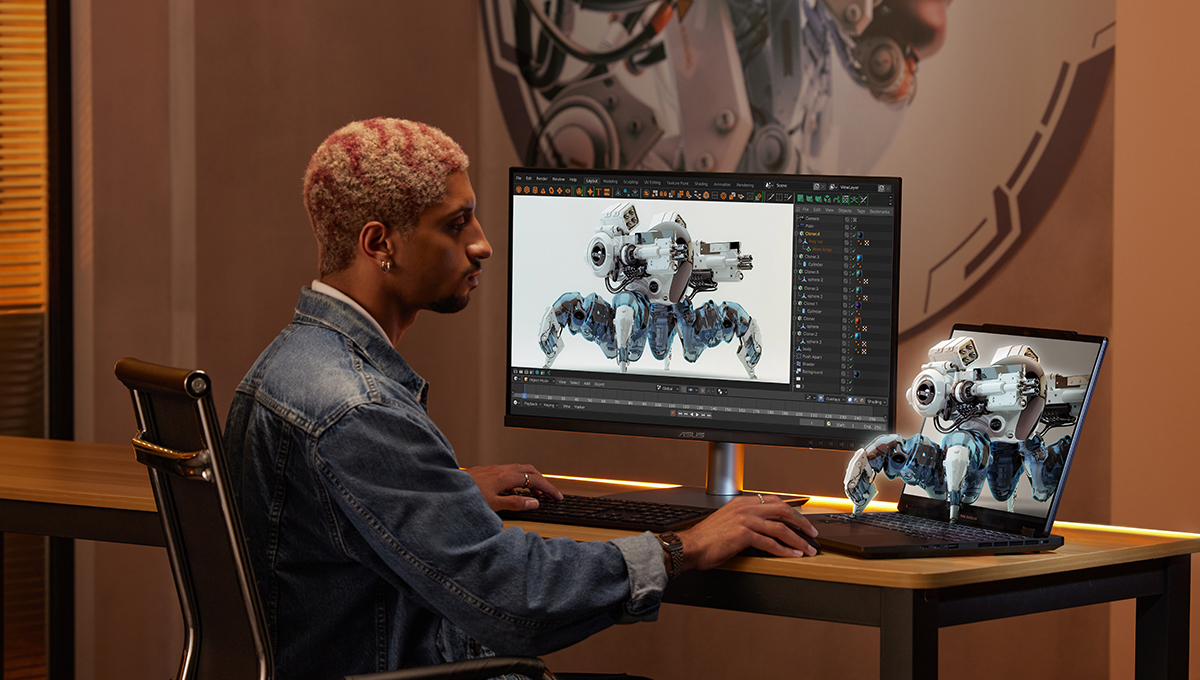
Jul 13, 2023
With the rising popularity of technologies like AR, VR, and 3D
displays, the demand for three-dimensional digital artwork is
skyrocketing. And with that, more people are entering the field of
3D creation, making the market more competitive. That means that as
a 3D designer, you need an edge. And a big part of gaining an edge
can be purchasing the right tools for the task.
One key tool you’ll need is a top-notch laptop made for the most
demanding 3D projects. What makes a laptop perfect for 3D design and
animation, you ask? Here are a couple of pointers on how to choose
the right one, as well as our recommendations.
Display
A laptop display that will meet the strictest requirements of
professional 3D designers and animators needs to have a few
characteristics: it needs to be responsive and fast, color-accurate,
large enough to comfortably see everything, and if it can display 3D
directly on the laptop screen, that’s a massive plus.
A great option would be an OLED screen, such as
ASUS Lumina OLED. They offer 100% DCI-P3 color gamut coverage, minimal color
variance (Delta E < 2), deepest blacks possible on a laptop screen,
and are Pantone® validated for color accuracy!
ASUS now also offers an exciting technology that’s perfect for 3D
artists:
ASUS Spatial Vision. These world's first 3D OLED displays* allow users to see
three-dimensional content directly on the laptop screen, without
using any accessories such as glasses or VR goggles. Learn more
about
ASUS Spatial Vision Technology, here.
When it comes to display size, it's best if you opt for a 15- or
16-inch screen, which should provide enough viewing space while
keeping the chassis relatively compact for better portability. A
16:10 aspect ratio is also great as it provides you with added
vertical space.
CPU
The CPU, aka processor, is the brain of your computer. It carries
out the tasks you throw at it. As a 3D artist, you need a
top-of-the-line, high-performance option.
Key specifications here will be the number of cores, the thread
count, and the clock speed. A good benchmark would be one of the
most powerful laptop CPUs available: the Intel® Core™ i9-13980HX
processor. This beast of a CPU has 24 cores (8 high-performance
cores), 32 threads, and a base clock speed of 2.2 GHz, with a boost
of up to 5.6 GHz. This should make for a smooth, uninterrupted 3D
creation process.
GPU
The GPU, aka graphics card, is the part of your computer that is
responsible for processing the graphical tasks. Many creative apps
are quite graphics-heavy, so to ensure smooth operation when
creating 3D work, you will need a latest-generation, powerful,
discrete GPU.
A good benchmark for a laptop graphics card for 3D artists would be
the NVIDIA® GeForce RTX™ 4070 laptop GPU. With 8 GB of GDDR6 video
memory, it will prove powerful enough for 3D design and animation.
Any less powerful GPU may prove insufficient or might become
obsolete in a span of a few years.
RAM
RAM is the short-term memory of your laptop. It’s responsible for
storing data for immediate access that is required to run your
applications. And since creative apps are very RAM-hungry, you will
benefit from plenty of memory.
Opt for no less than 32 GB of memory for your laptop. It’s best if
you choose the latest, best RAM technology — namely DDR5 SO-DIMM.
Keep in mind that RAM sticks larger than 32 GB are rare in laptops,
so you will most likely find out that the laptops that offer more
than that do so by offering two SO-DIMM slots with a RAM stick of
memory in each (e.g., two 16 GB-sticks).
It’s a massive plus if you can also upgrade your RAM later, so pay
attention to whether the laptop has available slots, as opposed to
the memory stick being soldered to the motherboard. Another thing to
consider is the maximum RAM that your laptop can be upgraded to. You
can usually find this information in the laptop specs table.
Storage
As a 3D designer or animator, you need lots of space to keep your
files. Of course, you can choose to use external hard drives, but
you should have enough storage space onboard to have immediate
access to the most crucial files.
3D files take up a ton of space. For that reason, you should aim for
as much space on the SSD as possible. 1 TB is the absolute minimum,
but even that amount may mean you’ll be only keeping many crucial
files on the laptop’s drive while storing everything else on an
external SSD. 2 TB often proves more optimal for 3D artists,
however. If you can get even more, that will make things more
convenient. You will also need to consider the SSD technology used.
We recommend the latest M.2 NVMe™ PCIe® 4.0 Performance SSD variant.
As with RAM, storage can be upgraded on many laptops, which is a
great benefit since you can always add on more space if needed.
Check the laptop specs list for more information regarding available
SSD slots.
Cooling
As 3D work puts a heavy strain on all key components in a laptop, a
lot of heat is created —which can lead to discomfort (e.g., the
chassis of the laptop gets hot). More importantly, 3D work can slow
down your laptop due to so-called throttling — when the CPU slows
itself down to avoid overheating. In extreme cases, the heat can
even lead to long-term damage.
That's why good cooling will be crucial in a laptop for 3D work. You
will want a laptop that has a sufficient combination of
high-performance fans and heat sinks or a vapor chamber, and plenty
of vents that will allow for smooth heat dissipation. Heat sinks or
a vapor chamber will help with thermal management without making
your laptop noisy. A more novel solution like using liquid metal
applied on the CPU’s heatsink is also a recently emerging way of
ensuring top-notch heat dissipation in top-notch, high-performance
laptops.
A good measure of thermal performance for a laptop is the max TDP
(Thermal Design Power) of the CPU and the GPU. If a laptop can pull
off 150 watts or more, that means it’s a high-performance machine
with sufficiently powerful cooling.
I/O Ports and Wireless Connectivity
Chances are you are using more than just your laptop to create your
3D art. Most creatives opt for various peripherals, such as an
external monitor, mouse, keyboard, pen tablet, hard drive, etc.
Conveniently connecting all of that requires either a rich lineup of
I/O ports in the laptop or an external hub. Needless to say, it's
better if it's the former.
A laptop for a 3D artist should have at least two Thunderbolt™ 4
ports with power delivery and display support, two USB Type-A ports,
an HDMI port, and an audio jack. Additionally, if you can get your
hands on a machine with a built-in Ethernet port for a wired
Internet connection when stationary and an SD card reader for
downloading files from other devices, such as a camera, it would
benefit you as well.
To achieve top-notch wireless connectivity, seek out the latest and
most advanced technologies. Opting for WiFi 6E will guarantee speedy
downloads and uploads while selecting Bluetooth® 5.3 will ensure
seamless wireless pairing with other gadgets and peripherals.
Touchpad, Keyboard, and Other Inputs
Regardless if you work mostly in your studio or office or are
frequently on the go, you may prefer to use the laptop’s built-in
keyboard and mouse. If you want to use your laptop without any
peripherals, search for a laptop that includes a full-sized keyboard
with dished caps and ample key travel, along with a spacious and
precise touchpad.
Certain laptops take things up a notch by offering specialized input
tools designed for creators, facilitating the creative process and
making it more effortless to work with creative applications. The
ASUS Dial and DialPad are among these features, with the former
being a physical dial and the latter being a virtual rotary input
function. They enable users to swiftly and instinctively modify
various settings, such as brush size, opacity, or zoom, streamlining
workflows. You can learn more about
how ASUS Dial and DialPad help creators work efficiently
here.
Our Pick: ProArt Studiobook 16 3D OLED
As a 3D artist, you need a top-notch laptop. And for creators, it
doesn't get more top-notch than the latest
ProArt Studiobook 16 3D OLED.
This unique mobile creative workstation features the ASUS Spatial
Vision technology 3D OLED display that combines the benefits of OLED
with the wonders of glasses-free 3D for ultimate visual immersion.
You can see your art in three dimensions directly on your laptop
screen!
The ProArt Studiobook 16 3D OLED is crafted with world-class
creative pros in mind. It’s a powerful machine with the latest 13th
Gen Intel® Core™ i9 HX high-performance processor and a powerful
NVIDIA® GeForce RTX™ 4070 GPU to handle even the toughest workflows.
In addition, the plentiful 64 GB (32 GB x 2) RAM and massive 8 TB (4
TB + 4 TB) SSD make sure creation goes uninterrupted.
It also features the ASUS Dial for convenient creative control.
Compatible with hundreds of apps, including the most popular
creative software, it can be customized via the ASUS ProArt Creator
Hub app to fit perfectly into your unique workflows.
Last but not least, this beast of a creator laptop packs a full I/O
ports lineup, including two USB 3.2 Gen 2 Type-A ports, Two
Thunderbolt™ 4 with display and power delivery support, an HDMI 2.1
port, a 3.5 mm combo audio jack, an RJ45 Gigabit Ethernet port, and
an SD Express 7.0 card reader.
If your budget doesn't allow for the purchase of this ultimate
creator laptop, we have another, more budget-friendly laptop that
packs many of the benefits of the aforementioned laptop, including
the 3D OLED display. Be sure to check out the
ASUS Vivobook Pro 16X 3D OLED.
Please also note that both of these laptops are available with a
non-3D display while having all the other mentioned features.
Are you curious to learn more about ASUS Spatial Vision? Click the
button below!
Discover ASUS Spatial Vision
*As of November 15, 2022 based on internal ASUS market analysis,
comparing ASUS Spatial Vision technology to competing laptops with
an autostereoscopic 3D display, ASUS is the first to use an OLED
display with this technology.







